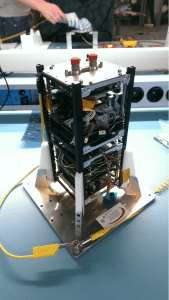QB50 Launch Switches from Alcantara Cyclone Space to NanoRacks and Kosmotras
[Via Satellite 01-29-2016] QB50, a project to launch 50 CubeSats for researching the Earth’s atmosphere, has shifted plans from launching with the Brazilian-Ukrainian Cyclone 4 rocket to instead launching with NanoRacks and Kosmotras. The mission, scheduled to begin this year, split into a series of multiple launches after Alcantara Cyclone Space’s Cyclone 4 project stalled out.
“We will be launching 40 satellites from the International Space Station (ISS) through services provided by NanoRacks,” Jan Thoemel, project manager for QB50, told Via Satellite. “[And] we will carry out two Dnepr campaigns. One is optimal for our scientific objective and the other one … is perfect for two in-orbit demonstration satellites.”
Having already experienced delays, the Cyclone 4 program unraveled following Russia’s annexing of Crimea from Ukraine, which caused significant destabilization in the country. The rocket was designed to launch 5,685 kg to a 200 km Low Earth Orbit (LEO), 3,910 kg to a 400 km Sun-Synchronous Orbit (SSO) or 1,600 kg to a 170 km Geostationary Transfer Orbit (GTO). Thoemel said QB50 was very interested in the new launch system before political events forced a change.
“We were very hopeful for Alcantara Cyclone Space,” he explained. “That was an excellent cooperation between Ukraine and Brazil, because one country had a rocket with no launch pad and the other a launch pad with no rocket. We were very happy at the time that they wanted to launch us. They made a good deal and had a performance rocket. We had seen most of the rocket parts at the time, and then these tragic events in Ukraine happened, and also some hesitance on the Brazilian side. Then, they were not able to commit anymore to the launch for QB50.”
The QB50 mission consists of a network of CubeSats that will study Earth’s upper thermosphere, measuring oxygen levels, electron behavior and more. The notion to use CubeSats for a large scientific mission came from two former European Space Agency (ESA) employees: Jean Muylaert — who is now director of the von Karman Institute — and the late Ruedeger Reinhard, who served as a consultant. The European Commission agreed to fund the program with an $8.7 million (€8 million) grant for all phases from early design to operations.
The QB50 organization is responsible for launcher procurement, handling coordination between satellite builders, and carrying out scientific activities. QB50 does design sensors, but the CubeSats themselves come from partners largely in academia. Thoemel said around 50 universities from 27 countries including Belgium, Ukraine, Turkey, Russia, China, Australia, the U.K. and the U.S. are building spacecraft and are also providing their own ground stations.
Two QB50 demonstration satellites from Innovative Solutions in Space (ISIS) launched in 2014 from a Dnepr rocket. Thoemel said the new launcher arrangements required some augmentation to the overall project, but that QB50 will still be able to complete its full mission.
“There was a little scientific drawback with the ISS. The inclination is relatively low, 52 degrees, and the thermosphere is particularly active over the poles, so we would also like to measure there. We will launch a number of satellites through a separate campaign with the Russian Dnepr rocket. That has a polar orbit so it will take complementary measurements over the poles. That’s the launch scenario. We have completed the agreements for the ISS and for Dnepr we are on the way to do that. It is likely that will happen by mid-next year. We are really now at the end of the preparation for the launch,” he said.
Neither Kosmotras nor NanoRacks responded to questions from Via Satellite regarding QB50. Thoemel said interactions with Kosmotras appear nominal despite the Dnepr rocket being a joint Ukrainian-Russian program. He listed the four goals of QB50 as furthering science, simplifying access to space, boosting education and enabling new technology, which the project will be able to fully accomplish. CubeSats from the ISS will launch into an orbit around 400 kilometers, which Thoemel said would equate to roughly a one-year lifespan depending on solar weather. Dnepr-launched satellites would last a couple of years before deorbiting, which he assured still preserves the safety of the space environment.
“Many people are worried about QB50 and its implications on space debris and collision risks, but this was addressed right from the beginning once we designed the scientific objectives. We wanted to go forward in the thermosphere and not go into higher orbits that would be unsafe,” he said.
Thoemel said QB50 has been a very collaborative program, with satellite-building teams working together in person and remotely via phone and Internet to share ideas. He added that countries with multiple QB50 participants are often working together on testing campaigns and conforming to their country’s regulations, such as the U.S. and Australia. QB50 also hosts annual workshops where there are presentations and meetings to share lessons learned in the process. Thoemel said there are musings about a second QB50 mission occurring in the future. Though the current mission is 50 CubeSats, the program originally received around 100 proposals.
“We are developing ideas for a new mission like QB50. We prove that involving a community is enabling to new science. The collaboration with so many researchers from all over the world is also rewarding. We are currently approaching agencies and discussing with them a possible follow-on. Agencies are interested in applications like research into space weather and Earth observation,” he said.
